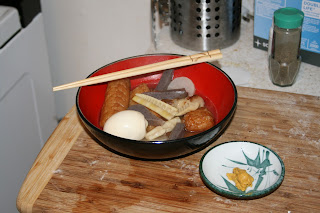Now, while I will fully admit that I have loved some butter-fried hamburgers in the past, over the course of the past year or two my tastes have dramatically shifted. My wife has expressed similar thoughts, and we're both concerned about our budget and our waist-lines. It's easy to fall into a comfort food trap, especially around the holidays. We already live in a stressful environment (learning to work on aircraft ain't easy!), we've bills to pay, all the usual complaints. Food has gotten wasted a couple times, sometimes without even being cooked. Our consumption of carbonated beverages and pain relievers has skyrocketed. Top that off with having been feeling too busy to properly cook, a long trip with the expectation that we're to gorge ourselves on roasted fowls and pigs (not to mention all the carbohydrate dense sides), and long hours at work for the wife, and things have begun to get a little ugly feeling.
So it's time for some things to change. I personally am on a quest to limit myself to only one single serving of soda per day, and replace my fluid consumption with water and tea. The wife is taking her lunch with her daily, and seems to prefer vegetarian dishes because of how much longer the vegetable fiber hangs around. When we're able, we'll be consuming more products from the sea, preferably grilled or steamed fish if we can't get decent sushi/sashimi grade.
One of the nicest ways in our experience to change (especially after a day like Thanksgiving Day) is having a day where you don't really eat. I'm not suggesting fasting (which does appear to have its health uses), just merely a change in consumption. We had that yesterday and we both felt immediately better, which to me made the oden I prepared all the more enjoyable. I think through the course of the day I had some leftover turkey, one bowl of rice with some edamame and that was it until dinner time. Granted, after dinner we slipped up a little bit and I procured some gyoza, but all in all we did much better for ourselves yesterday. We also discussed and began planning for having a week of mostly vegetable consumption, followed by (at least) several days of having a vegetarian diet.
I've been taken of late by shojin ryori, because quite literally it is the Zen of cooking. I'm not about to run off and take vows, but I am striving to better myself. The process of improving one's mind and soul is difficult, especially if you aren't feeling well. Meditation and exercise are most helpful, and will soon be the focus of some sort of plan to get and keep myself healthier. Stripping away soda and excess consumption seems to be a great start on the dietary end, but what else can I do to balance these principles with my love for tonkatsu or turkey and cornbread dressing? Perhaps a sort of detoxification on a culinary level might be needed. It makes sense to us in that light.
Tonight I didn't feel like cooking meat at all, although it's still on the menu for this week. I made a huge (by out standards) pot of vegetarian dashi and loaded it with shitake, nameko, and cremini mushrooms, then added a little soy sauce, mirin, and spring onion. It has made the entire house smell absolutely amazing!
Having that with some rice didn't seem like it would ultimately be very healthy, so I committed to making some vegetable tempura. I was too lazy to cut up the kabocha we bought in Austin, but I did slice up some onion and green beans, then skewer them along with some more mushrooms and cruciferous veggies. A quick turn through the batter and the fryer while I boiled some more edamame, and boom! a quick and easy dinner topped off by some takuan.
So here we are with a plate full of deep-fried goodness, ne? No, frying is not the absolute healthiest way to cook one's food. But this meal contains absolutely no animal products. It's got a large dose of fiber, a decent load of vitamins and minerals, and was quite satisfying on such a blustery, wind-swept evening as tonight. Tomorrow night, I will probably go ahead and make tonkatsu, given that I have very clean frying oil sitting in a pot on my stove and I'd hate to waste it by just throwing it away. After that, we're probably back to soup and vegetables for a while, with maybe some canned tuna or salmon thrown in if I'm in a crunch for time.




